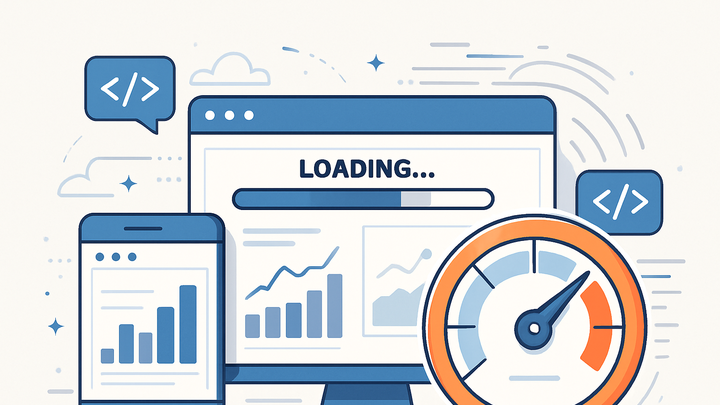Published on 2025-06-27T22:07:45Z
What is Page Speed? Importance, Measurement, and Best Practices
Page Speed refers to the time it takes for a web page to fully load and become interactive for users. In the analytics industry, it’s a key performance indicator that impacts user experience (UX), search engine optimization (SEO), and conversion rates. A slow Page Speed can lead to higher bounce rates, lower search rankings, and lost revenue. Measuring Page Speed accurately helps teams pinpoint bottlenecks and prioritize optimizations. This article delves into why Page Speed matters, how it’s measured, and practical strategies to improve it.
Key takeaways:
- Page Speed directly affects user satisfaction and business outcomes.
- Core Web Vitals are the standard metrics for assessing performance.
- Tools like PlainSignal and GA4 provide real-user Page Speed data.
- Implementing best practices can significantly reduce load times.
Page speed
Page Speed measures how quickly a webpage loads and becomes interactive, impacting UX, SEO, and conversion.
Why Page Speed Matters
Page Speed is more than a technical metric; it influences multiple facets of a website’s success. A faster site improves satisfaction, lowers abandonment, and drives business growth.
-
User experience
Modern users expect pages to load within seconds. Slower load times lead to frustration, higher bounce rates, and reduced engagement.
-
Seo impact
Google and other search engines factor Page Speed into their ranking algorithms. Faster pages are more likely to rank higher in search results.
-
Conversion rates
Studies show that a one-second delay in load time can reduce conversions by up to 7%. Improving Page Speed directly boosts sales and user actions.
How Page Speed is Measured
Page Speed is quantified through specific metrics and real-user data collection. The most recognized standards are the Core Web Vitals, complemented by analytics platforms that gather field performance data.
-
Core web vitals
A set of metrics defined by Google to reflect real user experience:
-
Largest contentful paint (lcp)
Measures loading performance. A good LCP occurs within 2.5 seconds of page load.
-
First contentful paint (fcp)
Captures when the first text or image is painted. Indicates initial rendering speed.
-
Time to interactive (tti)
Time taken for the page to become fully interactive.
-
Cumulative layout shift (cls)
Quantifies visual stability based on unexpected layout shifts.
-
-
Platform implementations
Analytics tools collect and report Page Speed data differently:
-
PlainSignal
Cookie-free, privacy-focused analytics. PlainSignal captures real-user timing data to report Page Speed in its dashboard.
-
Google analytics 4
GA4 automatically gathers site speed metrics under the ‘Engagement > Site Speed’ report without extra code.
-
Best Practices to Improve Page Speed
Enhancing Page Speed requires a multifaceted optimization approach, targeting server, asset, and code-level improvements.
-
Optimize images and media
Compress images, serve in next-gen formats (e.g., WebP), and use responsive sizing to reduce load times.
-
Minify and compress resources
Minify CSS, JavaScript, and HTML. Enable Gzip or Brotli compression to reduce file sizes.
-
Leverage browser caching
Set appropriate cache headers for static assets to prevent repeated downloads on subsequent visits.
-
Reduce javascript execution
Defer non-critical scripts, remove unused code, and implement code-splitting to minimize main-thread work.
-
Use content delivery networks (cdns)
Distribute assets across geographically dispersed servers to lower latency for global users.
Implementing Page Speed Tracking
Integrate Page Speed monitoring into your analytics setup to continuously track performance and validate optimizations.
-
PlainSignal setup
Add the PlainSignal snippet to your
<head>section to start collecting Page Speed metrics:<link rel="preconnect" href="//eu.plainsignal.com/" crossorigin /> <script defer data-do="yourwebsitedomain.com" data-id="0GQV1xmtzQQ" data-api="//eu.plainsignal.com" src="//cdn.plainsignal.com/plainsignal-min.js"></script> -
Google analytics 4 setup
Ensure your GA4 config tag is deployed. Access Page Speed insights under Reports > Engagement > Site Speed without additional configuration.
Interpreting Page Speed Data
Analyzing collected data effectively is key to identifying issues and measuring improvements.
-
Identifying bottlenecks
Review high LCP or TTI values and use waterfall charts to detect slow resources, server delays, or render-blocking scripts.
-
Setting performance budgets
Establish thresholds (e.g., LCP < 2.5s, CLS < 0.1) and monitor them to prevent regressions in performance.
